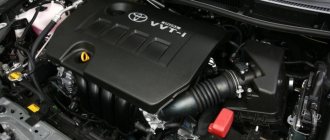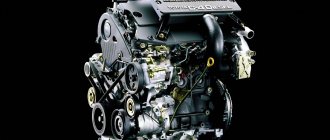Initially, the 3S GE engine was a joint development of Japanese companies. The manufacturer Toyota was the customer for the internal combustion engine project, Yamaha proposed the original design of the cylinder head. The GE execution is deciphered as follows:
- gas distribution according to the DOHC 16V scheme, that is, 4 valves per cylinder, overhead camshafts;
- timing belt drive of two camshafts at once, this is the main difference from the FE version, where the intake camshaft is rotated by a belt, and the exhaust gear from it;
- forced head with OSTS gasket, VVTi timing adjustment clutch on the intake camshaft and mechanical valve lifters with shims underneath them.
ICE 3S GE
Later, phase shift was added to the exhaust camshaft according to the Dual VVTi scheme, and hydraulic compensators appeared. In five subsequent versions of the engine, the intake tract, intake and ignition systems were changed. There was a constant boost that did not affect the volumes of the combustion chambers. That is, the main task of the manufacturer was to increase power and emission safety standards.
Technical characteristics of 3S GE 2.0 l
Initially, in the first generation engine, the designers achieved parameters of 186 Nm and 160 hp. With. However, the use of such engines was recommended only for the Japanese domestic market. “Strangled” up to 135 liters were exported to North America. With. motors that comply with Euro-3 standards.
T-VIS system
The architecture and engine layout were developed for a transverse arrangement under the hood of front-wheel drive vehicles. The first generation intake was regulated by the T-VIS system, which closed the runner at low speeds; the manufacturer did not use the EGR valve for exhaust recirculation.
ACIS system
In the second generation, the manual contains a description of another intake adjustment system - ACIS, and the outdated T-VI is present exclusively on the turbocharged version of the 3S GTE. Up to 191 Nm of thrust and 165 hp of power are added. With. for internal and 156 l. With. for the foreign market.
Then the camshaft upgrade provides a compression ratio of 10.3, power for Japan and Europe increases to 178 hp. With. and 168 l. s., respectively. For all subsequent generations, a feature is the presence of VVTi for phase adjustment and the corresponding BEAMS inscription on the valve cover.
The red Red Top cylinder head indicates an engine power of 187 hp. With. (automatic transmission) or 197 l. With. (manual transmission). Engines with a gray plenum and a black valve cover may not have the same settings. Due to the presence of VVTi and hydraulic compensators, the manufacturer recommends the use of high-quality engine oil.
Red Top 3S GE
The fifth and latest generation of 3S GE engines is equipped with Dual VVTi; for manual transmissions, it has titanium valves and emergency fuel supply to injectors; for automatic transmissions, valves are made of alloy steel. A slight decrease in power drive power for automatic transmissions is compensated by increased throttle response at 4800 rpm.
The technical characteristics of 3S GE are reflected in the table below:
| Manufacturer | Toyota Motor Manufacturing Kentucky, Yamaha, Kamigo Plant |
| Engine brand | 3S GE |
| Years of production | 1984 – 2005 |
| Volume | 1998 cm3 (2.0 l) |
| Power | basic version 135 – 160 l. With. I generation 156 – 165 liters. With. II generation 170 and 180 liters. With. III generation 180 – 200 l. With. IV generation 200 l. With. V generation 210 hp With. |
| Torque moment | basic version 186 Nm (at 6400 rpm) I generation 191 Nm (at 7000 rpm) II generation 191 Nm (at 7000 rpm) III generation 210 Nm (at 4800 rpm) IV generation 216 Nm (at 4800 rpm) V generation 216 Nm (at 6400 rpm) |
| Weight | 117 kg |
| Compression ratio | basic version 9.2 I generation 10 II generation 10.3 III generation 11.1 IV generation 11.1 V generation 11.5 |
| Nutrition | injector |
| Motor type | in-line petrol |
| Ignition | switching, contactless |
| Number of cylinders | 4 |
| Location of the first cylinder | TVE |
| Number of valves on each cylinder | 4 |
| Cylinder head material | aluminum alloy |
| Intake manifold | duralumin |
| An exhaust manifold | cast iron |
| Camshaft | II generation 244/244 lift 8.5/8.5 mm and 236/236 lift 8.2/8.2 mm III generation 240/240 lift 8.7/8.2 mm and 252/240 lift 9.8/8.2 mm IV generation 256/244 lift 10.5/9.2 mm |
| Cylinder block material | cast iron |
| Cylinder diameter | 86 mm |
| Pistons | cast on naturally aspirated and forged on turbo engine |
| Crankshaft | cast iron, five-support, 8 counterweights |
| Piston stroke | 86 mm |
| Fuel | AI-95 |
| Environmental standards | Euro 4 |
| Fuel consumption | highway – 8.0 l/100 km combined cycle 9.5 l/100 km city – 13 l/100 km |
| Oil consumption | maximum 0.8 l/1000 km |
| What kind of oil to pour into the engine by viscosity | 5W30, 10W30 |
| Which engine oil is best by manufacturer | Liqui Moly, LukOil, Rosneft |
| Oil for 3S GE by composition | synthetic in winter, semi-synthetic in summer |
| Engine oil volume | 4.5 l |
| Operating temperature | 95° |
| ICE resource | declared 250,000 km actual 350,000 km |
| Adjustment of valves | pushers/hydraulic compensators |
| Cooling system | forced, antifreeze |
| Coolant volume | 7 l |
| water pump | Aisin WPT010 |
| Spark plugs for 3S GE | Denso K20R-U11, K20R-ZU11, PK20R11, NGK BKR6EP-11 |
| Spark plug gap | 1.1 mm |
| Timing belt | Kent SUN 25/177 |
| Cylinder operating order | 1-3-4-2 |
| Air filter | Shinko SA-161 |
| Oil filter | Buil/VIC C-110, C-113 |
| Flywheel | 6.5 – 7 kg, for 8 bolts, center-to-center distance around the circle 13.5 mm |
| Flywheel mounting bolts | M12x1.25 mm, length 26 mm |
| Valve stem seals | Toyota 90913-02090 intake Toyota 90913-02088 exhaust |
| Compression | from 13 bar, difference in adjacent cylinders maximum 1 bar |
| XX speed | 750 – 800 min-1 |
| Tightening force of threaded connections | spark plug – 25 Nm flywheel – 62 Nm clutch bolt – 25 Nm bearing cap – 68 Nm (main) and 67 Nm (rod) cylinder head – three stages 49 Nm + 90° |
The manual contains maintenance regulations and a detailed description of operations that allow you to carry out major repairs in the garage.
The best authors in this topic. Cooling system
0 AT Brand country Japan Vehicle class D Body type Sedan Number of doors 4 Number of seats 5 Dimensions Length, mm 4,400 Width, mm 1,720 Height, mm 1,410 Wheelbase, mm 2,670 Front track, mm 1,495 Rear track, mm 1,485 Ground clearance, mm 135 Tire size 195 65 R15 Weight and volume Curb weight of the car, kg 1330 Minimum trunk volume, l. When using low-quality gasoline and a worn piston group, the pressure valve of the exhaust gas recirculation system becomes clogged.
Design Features
The 3S GE engine, originally modified by Toyota developers, has the following architectural features:
- cast iron liners in a cast iron cylinder block;
- duralumin cylinder head and intake manifold;
- steel tubular exhaust manifold;
- several camshaft options with different cam lifts and opening phases;
- high-life attachments driven by a common belt;
- separate timing belt for both camshafts at once;
- phase control system VVTi, and then Dual VVTi;
- T-VIS intake manifold, then ACIS with air volume control.
An exhaust manifold
Dual VVTi
At first, the DIS-2 ignition system with two coils was used, then DIS-4 and a personal coil on each cylinder without a bunch of high-voltage wires.
Common problems
The main problems with this unit are related to the BEAMS 3S-GE version. These are the last two generations, which were equipped with a VVT-i and Dual VVT-i gas distribution system. In our country, only the fourth generation of the engine is officially present, since the fifth was produced only for the Japanese version of the Toyota Altezza.
3S-GE under the hood of Toyota Altezza Toyota's new gas distribution system works great in Japan and America, where the quality of the fuel does not allow the engine power system to quickly fail.
In our conditions, the 3S-GE Yamaha engine, which according to the passport data requires 98-grade gasoline, simply breaks down after refueling in an unfamiliar place. Signs of such engine “poisoning” can be very different:
- the unit stalls in the middle of the road;
- does not start after several attempts;
- works intermittently or poorly;
- does not respond to pressing the accelerator pedal.
List of internal combustion engine modifications
During the years of mass production 1984 - 1998, the engine was modified 4 times:
- Gen 1 – 1984 – 1989, 135 – 160 l. s., 186 Nm/6400 min-1, compression ratio 9.2, T-VIS manifold (adjustable);
- Gen 2 – 1990 – 1993, 156 – 165 hp. s., 191 Nm/7000 min-1, compression ratio 10, camshafts with cam lift of 8.5 mm, phases 244, ACIS was used instead of T-VIS;
- Gen 3 – 1994 – 1999, 170 – 180 l. s., 210 Nm/4800 min-1, compression ratio 10.3, camshaft cam lift 9.8/8.2 mm, phases 254/240 degrees manual transmission and 8.7/8.2 mm, phases 240/240 for automatic transmission;
- Gen 4 – 1997, 180 – 200 l. s., 216 Nm/4800 min-1, compression ratio 11.1, a hydraulic phase distribution coupling was added to the intake camshaft, camshafts 8.56/8.31 phases 248/248 degrees, the diameter of the intake valves was increased to 34.5 mm, exhaust up to 29.5 mm;
- Gen 5 – 1998, 210 HP s., 216 Nm/6400 min-1, phase adjustment on both Dual VVTi camshafts, camshafts used from the first two versions.
Accordingly, the attachments and the firmware versions of the ECU software control were partially changed.
Generations
During the production period, the engine underwent numerous modifications and improvements; the unit has five modifications:
- First modification of the engine: Started in 84, the last copy was released in 89. The American and Japanese markets received two different engines. The American version had 135 horsepower, the Japanese engine was distinguished by aggressive settings and the absence of a device that regulates the flow of gases by connecting the space of the intake and exhaust manifolds. The absence of a device gave an increase in power (160 horses), but there were no environmental standards. A T-VIS device was used to change the shape of the intake port, which maintained momentum at low speeds.
Advantages and disadvantages
The performance characteristics of the engine are rated +5 points by users. The main advantages are:
- pistons cannot bend valves;
- low consumption of gasoline AI-92;
- major repairs are carried out in a garage on your own;
- resource exceeds 300,000 km.
The disadvantages are:
- diversity of generations, the parts of which can get confusing;
- on later versions there is an EGR valve, which either cokes or jams;
- on early modifications without hydraulic compensators, the adjusting washers are located under the pushers, which complicates the adjustment of the thermal clearances of the valves.
EGR valve
Initially, the engines of this series are forced, the drive is carried out on both camshafts. This is much more reliable than the S-FE, which is driven by a single camshaft and a gear drive to rotate the second timing shaft.
3-gen: for every taste Lubrication system
| About engines for Toyota Celica DOHC there are two camshafts as a drive, one of them transmits rotation from the crankshaft by a timing belt, the second by a gear from the previous camshaft;. The engine, modification 3S-FSE, having the same design characteristics in terms of volume and piston stroke, produced 150 horsepower at 6000 rpm. |
Turbine for 3S-GE/3S-GTE
For trouble-free operation of the GTE version, we simply make a chip and get our +30-40 hp. With. and no questions. To get serious power you need to remove the standard turbine, look for a turbo kit with an intercooler for the required power (the most balanced option is the Garrett GT28) and, depending on this, choose more powerful injectors (from 630cc), forged bottom (preferably), phase 268 shafts, fuel pump from Supra, straight exhaust on 76 pipe, AEM EMS setting. The config will show about 350 hp. With. A further increase in power is possible using a kit based on the Garrett GT30 or GT35, with a reinforced bottom end; it will drive fast, loudly, but not for long. — an erroneous opinion... with normal settings it goes for a long time.
Information must be verifiable, otherwise it may be questioned and deleted. You may edit this article to include links to authoritative sources. This mark was set on June 21, 2021
List of car models in which it was installed
Throughout its history, the 3S GE engine has been installed on the following Toyota cars:
- Carina – youth sedan with a sporty look;
- Carina E – three-door coupe;
- Camry – 7 generations of sedan of Japanese, Russian, Chinese, Australian and American production;
- Corona – large-sized station wagon;
- Altezza – business class sports car;
- Celica – convertible, liftback and hatchback;
- Town Ace – minivan for the Japanese market;
- MR2 – two-door sports car;
- Ipsum – minivan;
- Nadia – single-volume station wagon;
- Vista - a sedan produced only for Japan;
- RAV4 – the original crossover;
- Caldina – mid-size station wagon;
- Avensis is a medium format station wagon.
Toyota Vista
The internal combustion engine device was quite suitable for installation on the Holden Apollo sedan for the Australian market.
Prospects for tuning
From a practical point of view, tuning the 3S GE unit is not particularly relevant, since this engine is already good enough. An acceptable option for further pumping is as follows:
- grinding and finishing of the cylinder head, intake and exhaust channels;
- the use of balanced elements of a lightweight forged ShPG and a lightweight crankshaft;
- installation of valves with titanium plates, camshafts with a phase of 272° and a lift of 10.2 mm, a 4-2-1 spider and a direct-flow exhaust on a 63 mm pipe;
- connection to the on-board network of the fuel corrector Apexi S-AFC II (“Safk”-tuning).
The above measures will increase the engine power by about a quarter. A description of other, more “savage” methods of promoting the unit is not given in the article.
The reliable, durable design of the unit gives many reasons to use a 3S GE engine swap for other passenger cars. Although other 3S engines are no less popular, for example, 3S FE. A mileage of half a million kilometers without major overhauls with good maintenance is normal for these engines.
Maintenance schedule 3S GE 2.0 l
According to the design features, the 3S GE engine needs to replace consumables within the following periods:
- The timing belt and attachments must be replaced after 50,000 km;
- thermal valve clearances are adjusted after 30,000 miles;
- crankcase ventilation is cleaned every 2 years;
- Changing the engine oil and oil filter is recommended after 7500 km;
- the fuel filter should be replaced after 40,000 miles;
- The air filter must be replaced annually;
- additives inside antifreeze lose effectiveness after 40,000 km;
- The service life of spark plugs in the DIS-4 system is 20,000 mileage;
- A burnout in the intake manifold is possible after 60,000 km.
Replacing the timing belt
For turbocharged versions of the 3S GTE, replacement times are reduced by at least 30%.
Owner reviews
- My consumption on the highway was 9 liters, in the urban cycle 16 liters of gasoline with a 98 octane rating. This unit requires high quality oil, spark plugs and fuel.
- Operation of this engine is possible only when using 98 gasoline, since it does not contain anti-knock additives. The detonation of 92 gasoline is very high, so it is unacceptable to use it in this engine. The use of this type of fuel can shift the ignition timing, which will cause the vehicle's traction to deteriorate and consumption to increase.
We bring to your attention the price list for a contract engine (without mileage in the Russian Federation) 3S GE
Price list
Where was the engine installed?
Only the latest generations have become widespread. Initially, the 3S-GE motor was designed for Japanese and American consumers. The unit was installed on the following cars:
- Celica GT-S;
- Camry, Vista;
- MR2-G;
- Caldina, Caldina GT
- RAV4 – only in the Black Top BEAMS version;
- Altezza RS 200 – only in Japan.
Despite good potential and excellent efficiency, the engine was discontinued in 2005 due to the development of the third wave of Japanese power units.
3S-GE could not withstand the competition. Source










